The Downtown Fly Fisher,
Winnipeg - Part 2
By Bill Charles and Steve Abraham
SPECIES
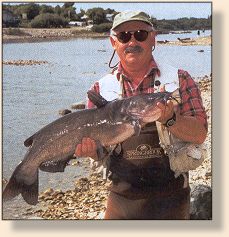
Channel Catfish
Channel catfish are the most common game fish within the
Red River and its tributaries. They are slow growing and
do not attain 30 inches in length until they are teenagers.
Some channel catfish have been aged at as much as 24 years,
and they can grow to more than 30 pounds.
Channel cats, which are most active in the early summer and
fall, inhabit mainly the deeper river channels and holes,
where they feed on goldeye and juvenile freshwater drum. Larger
flies, heavily weighted and fished on a sinking or sink-tip line
are necessary to get down to the bottom. I prefer white flies
with a bit of flash and the Cat Nip - a variation of the "flesh
flies" used in Alaska.
Takes are surprisingly gentle for such mean, nasty critters. But,
when hooked big cats move powerfully and deliberately. Frequently,
they sulk almost immovable on the bottom, with intermittent savage
head-shakes and rolls that will have you holding on with both
hands. Consequently, a large percentage of hooked cats never
see the net. For adrenaline junkies only!
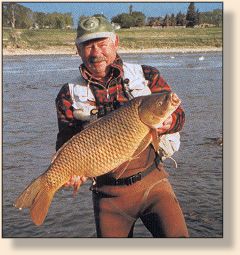
Carp
Long considered trash fish, carp have recently been getting a
great deal of well-derserved attention as a target species for
the fly fisher. The number of large capr in the Red and
Assiniboine rivers is staggering. Fishing for carp is very visual,
particularly in May through late June when the congregate to spawn.
They are are incredibly strong fighters that can show you your
backing on their first run.
Carp can be encountered throughout the season, but the most
productive period is in late spring and early summer, when they
come together to spawn. Due to the murkiness of the water, it's
possible to appraoch quite close to them, and it can be rather
unnerving to find yourself wading through huge schools of them
rolling in the shallows. In these conditions weighted nymphs are
the best bet. They can also be tempted with small minnow imitations
such as Steve's BND.
In late June, there is a large nocturnal Hexageniae
hatch on both the Red and the Assiniboine. At the same time,
clouds of cottonwood seeds are blown into the river. Carp feed
on these on the surface, and this is the best time to take them
on floating flies, preferably large, white, bushy patterns,
which can be used to suggest both flies and seeds.

Walleye and Sauger
Both walleye and their smaller cousins, the sauger, are abundant
in the lower reaches of the Red River. While sauger grow to
lengths of about 16 inches in the Red River, the walleye are
much larger. Every fall, mature walleye enter the Red River
from Lake Winnipeg and make their way upstream. Locally know
as "greenbacks," the large females can reach 14 pounds. It
is generally believed that the walleye are following their
primary food, the emerald shiner, and are feeding heavily.
Whatever the reason, they are concentrated and in the mood.
Yellow and chartreuse minnow imitations are the most productive
patterns.
Goldeye & Mooneye
While goldeye are encountered throughout the season, it is late
June that they really come into their own as a target species for the
fly fisher. At this time, the Red and Assiniboine Rivers host an
enormous Hexagenia hatch that brings both goldeye
and mooneye to the surface, providing excellent dry fly action.
Rather than holding stationary in the river, they travel in large
schools, grazing on the emerging mayflies as they go, when they
can be caught in significant numbers. The Assiniboine River near
Beaudry Park, just west of the city limits, is the place to be
when the hatch is one. Incidentally, smoked goldeye is a
Winnipeg delicacy. Give it a try - it's delicious.
Fresh water Drum
The freshwater drum, or sheepshead, is the only member of the
drum family found in fresh water. They are common in the main
stem of the Red River and the lower reaches of the larger
tributaries. A special set of muscles that vibrates against
the swim bladder produces a loud drumming or croaking sound
for which they are named. The exact purpose of this grunting
is unclear, but as only mature males exhibit the behavior,
biolgists suggest that it is most likely related to spawning.
They are opportunistic feeders and can be taken on a wide range
of sub-surface flies. While most drum encountered in the Red
and Assiniboine Rivers average about five pounds, they can
reach sizes in excess of 15. It is not uncommon for anglers on
the Red to encounter a large school that can result in strikes
on nearly every cast.
Emerald Shiner
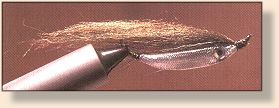 Body: Lead tape trimmed to shape with Pearl Mylar piping.
Body: Lead tape trimmed to shape with Pearl Mylar piping.
Wing: Black bucktail topped with Olive Widow's Web.
Eye: Prism eye.
 Cat Nip
Cat Nip
Body: Cross-cut white rabbit tied on thick.
Back: Witchcraft scale sheet cut to shape.
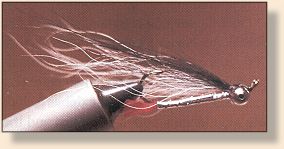 Steve's BND
Steve's BND
Tail: Red yarn.
Body: Flat silver tinsel.
Eyes: Silver bead chain.
Wing: White bucktail topped with black bucktail.
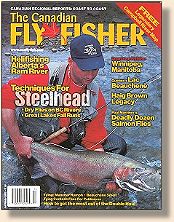 For More Information
For More Information
The Manitoba Fly Fisher Association's website at
www.mffa.mb.ca, is a great source of information, and you can
contact the membership with any questions on local conditions. In
additions, Get Hooked On Fishing In Winnipeg, a publication
available from Manitoba Natural Resources, is an excellent source of
information on access to the Red and Assiniboine Rivers within the
city limits, the species of fish found at each location. ~ Bill Charles and Steve Abraham
Credits: This article is from the
Canadian Fly Fisher magazine. We appreciate use permission!
Our Man In Canada Archives
|

